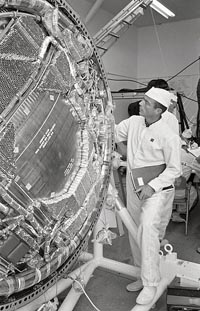This photo, which was taken on 24 May 24 1962, depicts Scott Carpenter peering into his Mercury-Atlas 7 spacecraft, the Aurora 7, before he was inserted into it to begin the launch. Image credit: NASA
It was on 24 May in 1962 that NASA astronaut Scott Carpenter became the second American to orbit the earth, after he piloted his Aurora 7 spacecraft through three revolutions, in a pioneering space science mission that lasted almost five hours.
Carpenter, who was also a test pilot and aquanaut, was also the fourth American in space. And he was also the first American to eat solid food in space!
According to NASA, he was the first human to go through both inner and outer space, thus earning him the dual titles of astronaut/aquanaut.
Born in 1925 in Boulder, Colorado, Carpenter studied at the University of Colorado where he received a bachelor of science degree in aeronautical engineering.
He was commissioned in the U.S. Navy in 1949. Between 1957 and 1959 he went to the Navy General Line School and the Navy Air Intelligence School. Carpenter was then assigned as air intelligence officer to the aircraft carrier, USS Hornet.
One of the original seven Mercury astronauts
It was in 1959 that NASA selected him as one of the original seven Mercury astronauts, and he underwent intensive training.
Then, in 1962, Carpenter was the back-up pilot for John Glenn during the preparation for America’s first manned orbital space flight.

Scott Carpenter pictured examining his Mercury capsule, the Aurora 7. Image credit: Wikipedia
As for his own manned space flight, Carpenter piloted the Aurora 7 spacecraft through three revolutions of the earth on 24 May 1962 . The Aurora reached a max altitude of 164 miles. And, after four hours and 54 minutes of flying, the Aurora 7 landed in the Atlantic Ocean, after a malfunction to the spacecraft forced him to manually control his re-enter the atmosphere and overshoot his planned splashdown point by around 400km.
He went on to participate as an aquanaut in the U.S. Navy’s SEALAB project. In 1965 he spent 28 days living on the ocean floor off the coast of California.
Carpenter then worked at NASA as executive assistant to the director of the Manned Spaceflight Center, while he also helped design the Apollo Lunar Landing Module.
An arm injury meant that he could never fly in space again, so he resigned from NASA in 1967.
Ocean research
He also retired from the Navy in 1969 and went on to found Sea Sciences, a venture capital corporation targeted at developing programmes to enhance ocean resources and improving the planet’s environmental health.
Carpenter worked closely with French oceanographer J. Y. Cousteau and has dived in most of the world’s oceans. He also dived into the Arctic under ice.
The character of Scott Tracy in the Thunderbirds TV series was named after him. Carpenter is now aged 87.